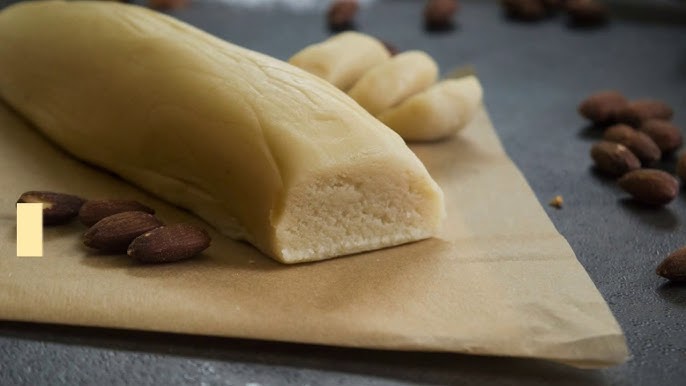Almond Paste Recipe: Almond paste is a rich, sweet, and nutty mixture made primarily from ground almonds and sugar. It serves as the foundation for countless delicious desserts and baked goods. Think of it as marzipan’s rugged, slightly less sweet cousin. Where marzipan is more about decoration—smooth, sculpted, and very sugary—almond paste is all about deep flavor and texture.
If you’ve ever bitten into an almond croissant and savored that gooey, fragrant filling inside, that’s almond paste at its finest. It’s used in everything from cookies to pastries to cake fillings. Its slightly gritty texture and rich almond flavor bring a luxurious depth to desserts that sugar alone can’t achieve.
Difference Between Almond Paste and Marzipan
Many confuse almond paste with marzipan, but they’re quite different in both taste and texture. Almond paste typically contains less sugar and has a coarser texture, making it perfect for baking and filling pastries. Marzipan, on the other hand, is much sweeter, smoother, and often molded into decorative shapes or used to coat cakes.
While both are made from similar ingredients—almonds and sugar—the ratios differ. Almond paste usually has a stronger almond flavor and isn’t meant to be eaten raw (though it’s perfectly safe). Marzipan is more of a candy, thanks to the extra sugar and sometimes added egg whites or syrup.
Common Uses of Almond Paste
Almond paste isn’t just a one-trick pony. It’s incredibly versatile and used in a variety of baked goods around the world. You’ll find it inside flaky almond croissants, mixed into dense fruitcakes, layered in Italian cookies, and swirled into Scandinavian pastries.
Want to give your plain pound cake a fancy twist? Add a dollop of almond paste to the batter. Craving a rich tart? Combine it with butter and sugar for a frangipane filling. The possibilities are as endless as your imagination—and your sweet tooth.
Ingredients You’ll Need
Simple Ingredients, Big Flavor
What makes almond paste so lovable is its simplicity. You only need a handful of pantry staples to make it at home:
- 1 ½ cups blanched almonds (or almond flour)
- 1 ½ cups powdered sugar
- 1 egg white (or 2 tablespoons corn syrup for an egg-free version)
- 1 teaspoon almond extract
- 1 teaspoon vanilla extract (optional)
- A pinch of salt
Each ingredient plays its part. The almonds are the star, of course, offering richness and texture. The sugar adds sweetness, the egg white binds everything, and the extracts boost the flavor to make your kitchen smell like a European bakery.
Choosing the Right Almonds
Almonds are the heart and soul of this recipe, so choosing the right kind matters. Go for raw, unsalted, blanched almonds if you’re starting from scratch. If you prefer shortcuts, almond flour or meal works just as well. Just make sure it’s finely ground—no one wants chunky paste.
The fresher the almonds, the better the flavor. Stale nuts can make your paste taste flat or even rancid. Store your almonds in the fridge or freezer if you’re buying in bulk to keep them fresh for longer.
Equipment You’ll Need
Must-Have Kitchen Tools
You don’t need fancy gadgets to make almond paste at home, but a few tools make the process smoother:
- Food processor or high-speed blender
- Measuring cups and spoons
- Spatula
- Mixing bowl (if not using the processor to mix everything)
- Airtight container or plastic wrap for storage
A food processor is ideal because it helps break down the almonds finely and blend everything into a smooth paste. A blender can work too, but it may need more patience and scraping.
Optional Tools for Extra Ease
If you want to take it up a notch, here are a few extras that can make your almond paste-making experience even easier:
- Nut grinder (for a finer almond texture)
- Digital scale (for precise measurements)
- Piping bag (for easy application in pastries)
While not necessary, these tools can help if you plan to make almond paste regularly or want the smoothest, most consistent results.
Step-by-Step Instructions
Step 1 – Blanching the Almonds
If you’re starting with whole almonds with skins, blanching is your first step. Bring a pot of water to a boil, add the almonds, and let them sit for about 60 seconds. Drain them and immediately rinse under cold water.
Now comes the fun part: popping them out of their skins. Just pinch, and the almonds will slide right out. Pat them dry with a towel and let them air dry for at least an hour before grinding. Moisture is the enemy of smooth almond paste.
Step 2 – Grinding to Perfection
Once your almonds are dry, toss them into a food processor with the powdered sugar. Pulse in short bursts until the mixture looks like fine sand. Don’t over-process, or you’ll end up with almond butter instead of paste.
You’re aiming for a fine, uniform consistency. The sugar helps prevent the almonds from turning into butter by absorbing the oils released during grinding. Make sure to scrape down the sides occasionally to keep things even.
Step 3 – Mixing the Paste
Add the egg white, almond extract, vanilla extract (if using), and a pinch of salt. Blend everything until a thick, sticky paste forms. It should hold together when pressed but still be pliable.
If it’s too dry, add a few drops of water or more egg white. If too wet, add a bit more powdered sugar. The key is balance—you want a moldable paste, not soup or rock.
Step 4 – Storing the Paste
Form the paste into a log or ball, wrap it tightly in plastic wrap, and store it in an airtight container. Let it chill in the fridge for at least 24 hours before using—it helps the flavors meld and the texture to firm up.
You can store it in the fridge for up to 10 days or freeze it for up to 3 months. Just thaw it in the fridge overnight before using.
Tips and Tricks for the Perfect Paste
Getting the Texture Just Right
Texture makes all the difference between a good almond paste and an exceptional one. You’re aiming for something that’s thick, pliable, and just a little grainy—not runny, dry, or overly smooth like marzipan. If your paste feels too soft or sticky, don’t panic. You can always add a bit more powdered sugar to firm it up. On the flip side, if it’s too crumbly, a few drops of water or an extra touch of egg white can work wonders.
Timing and patience are also key. Don’t rush the grinding process—give your almonds time to break down slowly without turning into almond butter. Using short pulses on your food processor helps prevent overheating and oil separation. Make sure to scrape down the sides of the processor often to ensure a consistent texture throughout.
Here’s a handy tip: chill your almonds in the fridge before processing. Cold almonds release less oil, reducing the risk of getting an oily, greasy paste. And always measure your ingredients with care. Precision pays off, especially when working with natural products like almonds, where size and oil content can vary.
Enhancing Flavor Naturally
Want your almond paste to taste like something straight out of a Parisian patisserie? Start by using high-quality, fresh almonds. That alone can elevate the entire batch. But to take things up a notch, a few flavor-boosting secrets come in handy.
First, toasting your almonds for a few minutes before grinding adds a rich, nutty depth that’s hard to beat. Just make sure they’re fully cooled before you toss them into the processor.
Second, don’t underestimate the power of almond extract. Just a teaspoon can intensify the natural almond flavor, making your paste more aromatic and vibrant. Vanilla extract can add warmth and roundness to the taste, balancing the nuttiness.
Lastly, a pinch of salt might seem insignificant, but it brings out the sweetness and adds complexity. You can also experiment with citrus zest, like orange or lemon, to give your paste a bright twist that works wonders in certain pastries.
Storing and Freezing Almond Paste
How Long Does It Last?
Homemade almond paste is a labor of love, so naturally, you’ll want to keep it fresh for as long as possible. Luckily, if stored correctly, it can last quite a while. In the fridge, almond paste keeps well for up to 10 days. Just be sure to wrap it tightly in plastic wrap and seal it in an airtight container. This prevents it from drying out and absorbing any fridge odors.
If you’re planning to use it sporadically over a longer period, freezing is your best bet. Properly stored, almond paste can stay good in the freezer for up to three months. When you’re ready to use it, let it thaw slowly in the fridge overnight. Avoid microwaving or exposing it to sudden heat, as that can mess with the texture.
A handy tip: divide your paste into smaller portions before freezing. That way, you only need to thaw what you need, keeping the rest perfectly preserved.
Best Practices for Freezing
Freezing almond paste is easy, but doing it the right way makes all the difference. First, wrap the paste in a double layer of plastic wrap, making sure there’s no air exposure. Then, place it in a resealable freezer bag or an airtight container. Label it with the date so you remember when you made it.
Avoid freezing and thawing multiple times, as this can degrade both the flavor and texture. And once thawed, give your paste a good knead to bring it back to its original smooth, pliable consistency. If it feels a bit dry after freezing, add a touch of egg white or warm water and knead until soft again.
Freezing is especially useful if you like having almond paste on hand for impromptu baking sessions. It’s like having a secret weapon in your freezer—ready to transform ordinary baked goods into something unforgettable.
Delicious Recipes Using Almond Paste
Almond Croissants
Nothing says indulgence like a buttery, flaky almond croissant filled with rich almond paste. And here’s the best part: you don’t need to be a professional baker to make them at home. Start with store-bought croissants (or make your own if you’re ambitious), slice them open, and fill with a generous layer of almond paste.
Brush the tops with simple syrup, sprinkle with sliced almonds, and bake until golden brown and crisp. The filling turns warm and gooey, the croissant becomes perfectly toasted, and the whole thing is just heavenly.
This is an ideal way to use up slightly stale croissants, too. In fact, that’s how traditional almond croissants were born—giving day-old pastries a new lease on life with a rich, nutty filling.
Almond Tarts and Cakes
Almond paste is also a star player in many European-style tarts and cakes. Try blending it with butter, sugar, and eggs to make a frangipane—a luscious almond filling that’s baked into tart shells, often topped with pears, plums, or berries. It puffs up beautifully in the oven, becoming soft, fragrant, and utterly addictive.
You can also fold almond paste into cake batters for added moisture and flavor. It pairs especially well with citrus flavors like lemon and orange, as well as dark chocolate. For something simple but delicious, try an almond loaf cake. It’s rich, subtly sweet, and perfect with a cup of tea.
Almond paste even shines in cookies. Think Italian amaretti or almond thumbprints—each bite chewy, sweet, and unmistakably nutty. Whatever your craving, there’s an almond paste recipe that can satisfy it.
FAQs about Almond Paste Recipe
1. Can I make almond paste without a food processor?
Yes! You can use almond flour instead of whole almonds to skip the grinding step. Mix the ingredients by hand or with a hand mixer until a dough-like paste forms. It takes a bit more effort, but it definitely works.
2. Is almond paste gluten-free?
Absolutely. Almond paste contains no wheat or gluten unless it’s contaminated during processing. Always check the labels on your almond flour or whole almonds to ensure they’re certified gluten-free if you have allergies.
3. Can I substitute almond paste with marzipan in recipes?
Sometimes. Marzipan is sweeter and firmer, so it’s not always an even trade. In baked recipes, almond paste usually works better because it has more moisture and a stronger almond flavor. If you must substitute, reduce the sugar in the recipe accordingly.
4. What can I do if my almond paste is too sticky?
Add more powdered sugar, one tablespoon at a time, and knead it in until the paste firms up. If it’s very sticky, chilling it for 15-20 minutes can also help make it easier to handle.
5. Can I use almond meal instead of almond flour?
Yes, but the texture may be slightly coarser. Almond meal contains the almond skins and is less finely ground, which might give your paste a grittier feel. It still tastes great though—just a little more rustic.
Conclusion
What’s truly special about making almond paste at home is how simple and rewarding it is. With just a few basic ingredients—almonds, sugar, and an egg white—you can create a paste that tastes fresher and more flavorful than anything you’ll find in a store. Plus, you get to control the texture, sweetness, and even infuse it with your own twist, like citrus zest or extra vanilla.
Another big bonus? It stores beautifully. Whether you keep it chilled for a week or frozen for months, almond paste is ready whenever inspiration strikes. So next time you’re eyeing a croissant or dreaming up a new dessert, remember: with a batch of homemade almond paste, you’re already halfway there.



